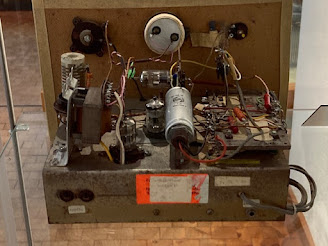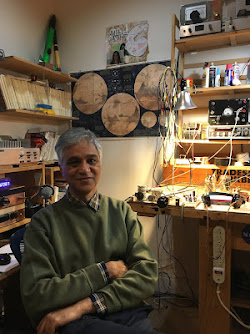Podcasting since 2005! Listen to Latest SolderSmoke
Thursday, June 8, 2023
Canadian Build of the Direct Conversion Receiver -- Do This in Your Town! (Video)
Tuesday, June 6, 2023
"Ham Radio Ireland" June 2023 edition (and Free Propagation Guide)
Get the latest edition here:
https://www.docdroid.net/VlSXkrD/crnews0623-pdf
Thanks to Steve Wright EI5DD. I had the great good fortune of running into my friend Michael EI0CL on the 17 meter band recently. Mike mentioned that he had been talking to Steve. So Steve is in good company.
Sunday, June 4, 2023
Can you ID this Receiver? Grayson Finds a Homebrew Receiver in Germany. From the GDR. Circuit? Schematic? Thermatrons?
Thursday, June 1, 2023
George Heron N2APB talks about Coherent CW at FDIM: Interview #7 by Bob Crane W8SX
It was great to hear George's voice again. I was a big fan of his "Chat with the Designers" podcast. And it was great to see that Pete Eaton WB9FLW (an old friend of SolderSmoke) was also involved in this presentation.
At FDIM George was talking about Coherent CW. Now, my views on CW have been made quite clear, but I am going to deliberately avoid snide comments about how Coherent CW might be a contradiction in terms. Thank you. I think this is something that Pete N6QW and I can agree on.
Nevertheless, this is all technically interesting. This reminds me of what happens with WSPR. But I wasn't quite sure what George was getting at with his discussion of the phase of the incoming signal -- I can see the need to get the receivers' narrow filter exactly on the transmitting station's frequency, but why the phase?
Here is Bob Crane's interview with George:
http://soldersmoke.com/N2APB23.mp3
And here are a couple of things with background info on CCW.
https://www.sigidwiki.com/wiki/Coherent_CW
http://www.arrl.org/files/file/Technology/tis/info/pdf/7509026.pdf
Thanks George, thanks Pete, and thanks Bob.
Wednesday, May 31, 2023
Farhan VU2ESE FDIM Interview (#6) by Bob Crane W8SX: VHF Rig, sBITX, and Good News on Raspberry Pi 4
Here us Bob's interview with Farhan:
http://soldersmoke.com/VU2ESE23.mp3
Tuesday, May 30, 2023
Rick Campbell KK7B at FDIM: Interview #5 by Bob Crane W8SX
Here is the interview:
http://soldersmoke.com/KK7B23.mp3
And here is a paper Rick did on VHF. It is a bit old, but it is good.
http://www.pnwvhfs.org/conference/2009/Introduction-to-VHF-Experiments.pdf
Thanks Rick! Thanks Bob!
Monday, May 29, 2023
Eric Schwartz WA6HHQ of Elecraft -- FDIM Interview #4 by Bob Crane W8SX (audio)
It was really cool that our correspondent at FDIM caught up with Eric Schwartz WA6HHQ of Elecraft. Some highlights from the interview:
-- Eric met Wayne Burdick through the NORCAL 40 (Wayne had designed it, and Eric was writing articles about it). That was a very influential rig -- it was the basis for a book and a CALTECH course by David Rutledge.
-- Elecraft has a strong QRP element in its DNA.
-- The K2 is "Heathkit style" and offers the builder the opportunity to understand the rig at the component level.
-- Eric says that using something you built yourself is worth at least 10db.
Here is Bob's interview with Eric:
http://soldersmoke.com/WA6HHQ23.mp3
Thanks Eric and thanks Bob.
Sunday, May 28, 2023
Jerry KI4IO (Wizard of Warrenton) Describes His ALL ANALOG Phasing Transceiver -- Bob Crane FDIM interview #3 (audio)
Wow, this one really resonated with me. Jerry had me won over when, early in the interview, he described his decision to dispense with the Si5351/Arduino combo: "I said the hell with this digital stuff!" I hear you Jerry. I feel your pain OM.
Jerry then goes on to describe a rig with bits of circuitry from some legendary sources: The Ugly Weekender transmitter. SSDRA and EMRFD. W7ZOI's 1968 Direct Conversion receiver.
Jerry discusses the "presence" of the direct conversion receiver. And he decries the pernicious effects of AGC. (Indeed, real hams MANUALLY control the gain.)
The Wizard of Warrenton then shares some important tribal wisdom: After building that new piece of gear, leave it on the bench for a couple of weeks. Beware of "radio infatuation" (what a great term -- we will have to include this in the lexicon). Jerry points out that while at first, the new rig will seem just perfect, with time time the need for improvements and modifications will become apparent.
Jerry also has connections to India and Nepal (where he helped Father Moran). See: https://www.qrz.com/db/KI4IO
Here is W8SX's interview with Jerry:
http://soldersmoke.com/KI4IO23.mp3
Thanks Jerry! Thanks Bob!
Greg Latta AA8V on Making Aluminum Chassis -- FDIM Interview by Bob Crane W8SX #2 (audio)
Our correspondent Bob Crane W8SX caught up with prolific builder Greg Latta AA8V. Greg gave an FDIM talk on how to make aluminum chassis without having a machine shop. I guess I am now going to have to buy a belt sander from Amazon.
I was really glad that Greg mentioned his real passion: retro building. FB Greg. I have talked to Greg several times on the ham bands -- it is always an inspirational experience.
Here is Bob's interview with Greg:
http://soldersmoke.com/AA8V23.mp3
Here is Greg's pdf file on his aluminum chassis construction technique.
https://www.frostburg.edu/personal/latta/ee/chassis/aluminumchassisconstructionnomovies.pdf
And here is Greg's amazing web site:
https://www.frostburg.edu/personal/latta/index.html
Thanks Greg! Thanks Bob!
Saturday, May 27, 2023
Hans Summers G0UPL and his new QMX: The Bob Crane W8SX FDIM Interviews Part 1 (audio)
We are very pleased and grateful to present this year's series of Four Days in May interviews by our FDIM correspondent Bob Crane W8SX. Once again Bob did an outstanding job interviewing the FDIM participants.
In this interview, the amazing Hans Summers talks about his latest QRP Labs kit, the QMX. It is a combination of the QCX Mini and the QDX.
Hans explains the M: QMX. The M is for Marriage. Magnificent. Merger. Marvelous, many things like that. It’s what you get when you marry the mechanical and conceptual design of QCX-mini, with the SDR, multi-band digital implementation of QDX. Simply: QDX + QCX-mini = QMX.
It has a very clever switching power supply that automatically adjust to prevent spurs and harmonics from the power supply from appearing in the band of interest.
I was especially interested in his plans to implement an SSB option in future software updates. Hans will use the same very complicated SSB generation scheme used in the trueSDX rig, but hopes to achieve higher performance and improved signal quality due to the much more robust hardware of the QMX.
Here is the interview:
http://soldersmoke.com/G0UPL23.mp3
Here is the QRP Labs site about the QMX: http://qrp-labs.com/qmx.html
Here is the QRP Labs web site: http://qrp-labs.com/
And here is a really wonderful and very current article by Hans on the evolution of QRP Labs and its rigs from 2010 right on up through 2023 and the QMX. It is really interesting:
http://qrp-labs.com/images/qmx/docs/fdim2023.pdf
Thanks to Bob Crane W8SX, Hans Summers G0UPL, and all of the FDIM organizers.
Friday, May 26, 2023
Coffee with Farhan VU2ESE (video)
Thursday, May 25, 2023
PSSST! MostlyDIYRF Will Sell a Kit of Pete's Rig!
From the wizard of Newbury Park!The Pssst Transceiver Kit | |||||
 | |||||
| |||||
 | |||||
Available on the 150th birthday of Lee DeForest, the inventor of the Triode (August 26th) |








































